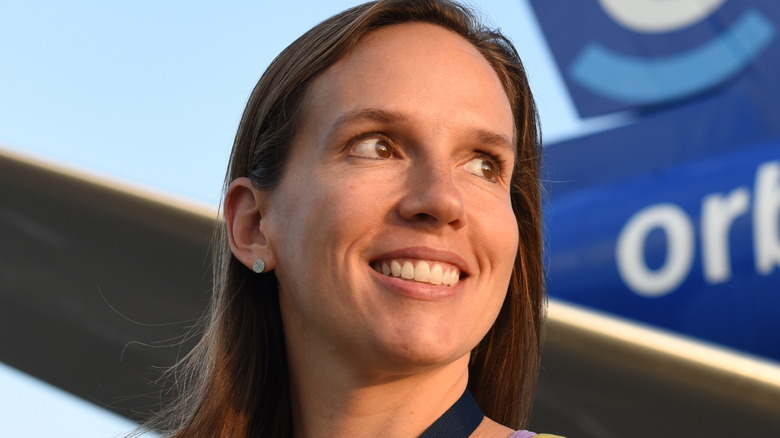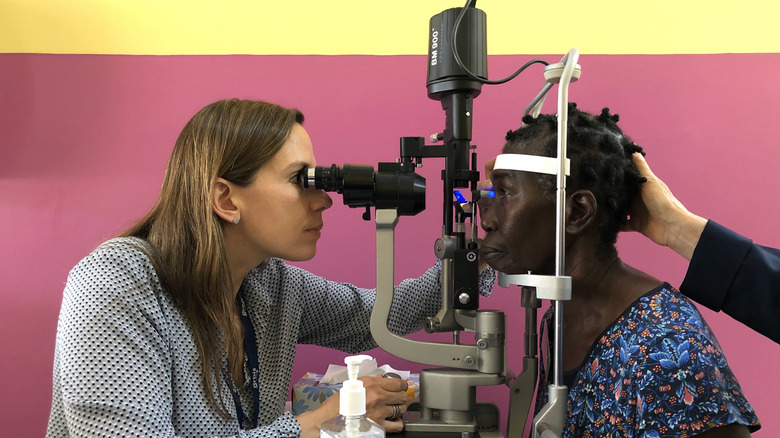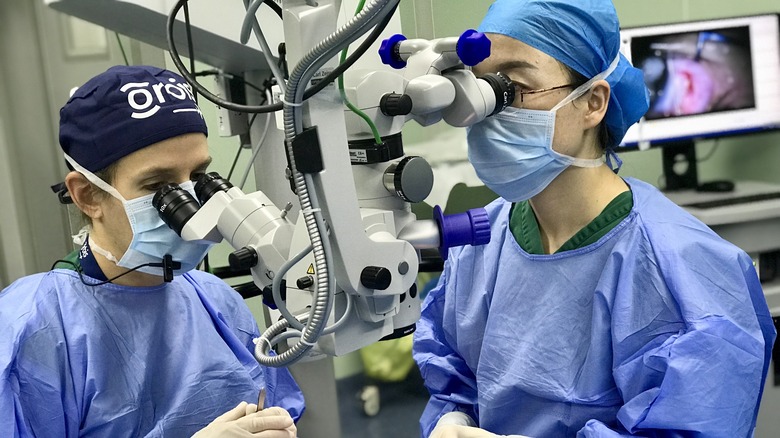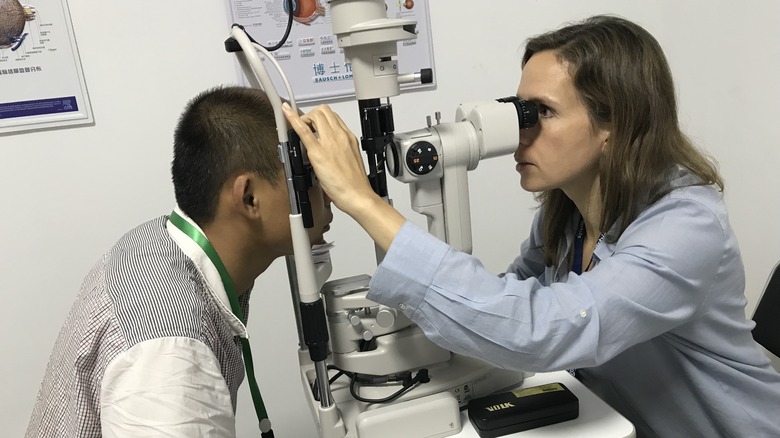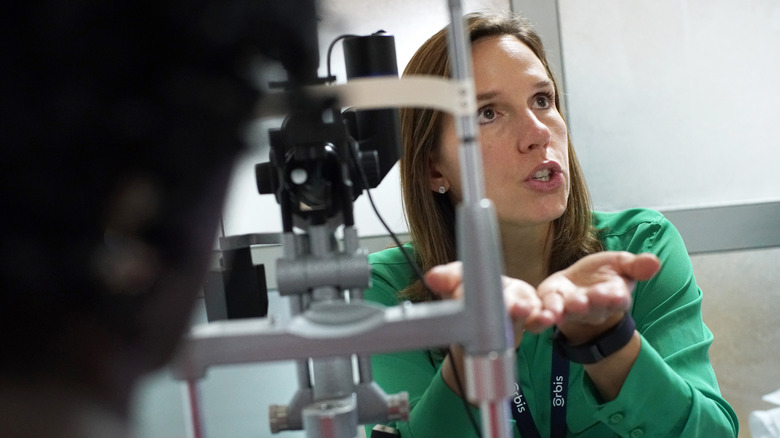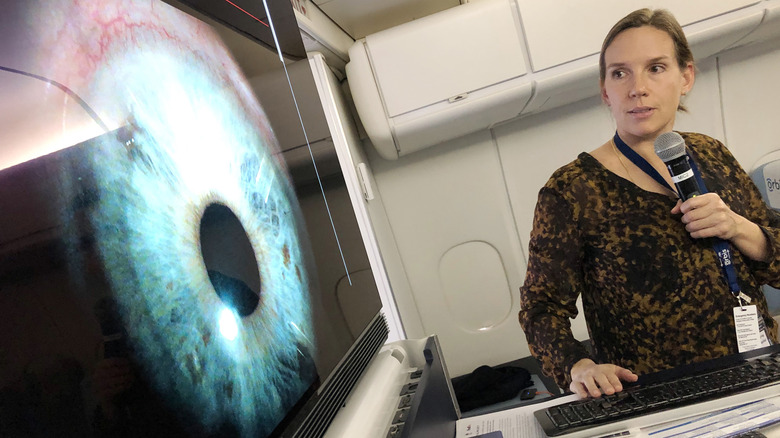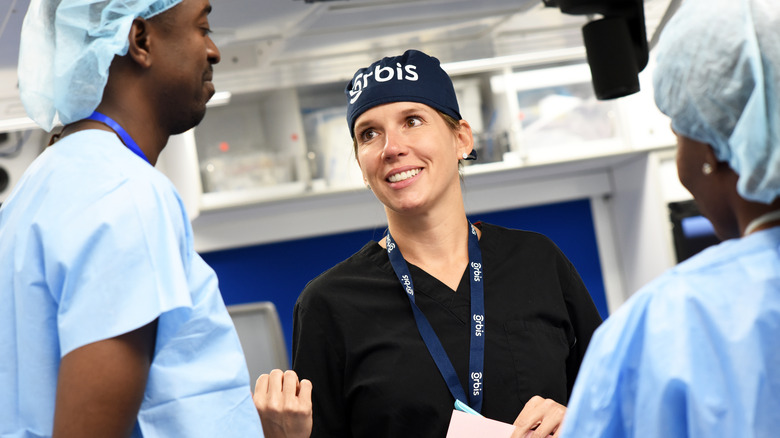Ophthalmologist Annette Giangiacomo On Glaucoma, Eye Health, And Orbis' Flying Eye Hospital - Exclusive Interview
Dr. Annette Giangiacomo is one of the many ophthalmologists around the world on a mission to prevent vision loss. As a glaucoma specialist, she helps adults and children treat and manage the disease so they can keep their vision for the rest of their lives. When necessary, Giangiacomo uses sophisticated surgical and laser interventions to ensure that her patients' eyes stay as healthy as possible.
Because glaucoma can develop without any noticeable symptoms, it often goes undetected until it's too late, leading to irreversible damage and sometimes blindness. However, if it's diagnosed early, glaucoma is easily managed. In addition to direct patient care, Giangiacomo provides education on how to catch glaucoma early.
In an exclusive interview with Health Digest, Giangiacomo discussed the importance of regular eye appointments, the everyday things you can do to keep your eyes healthy, and the work she does with the non-profit Orbis International to bring affordable eye care to the world.
The eyes as indicators of overall health
Why did you decide to pursue ophthalmology?
As a medical student, I had an instant connection with ophthalmology because it can tell you a lot about the body. Your eyes can give clues to your overall health; they can tell you a lot about diabetes, problems with the brain such as stroke, and all types of neurological or primary care problems that I never expected. It was very exciting to see how the eye could reveal so much.
Why did you choose to specialize in glaucoma?
I am a glaucoma specialist, and I treat adults and children with glaucoma; it's my passion. I love the primary care aspect that glaucoma care provides for me and being able to have a relationship with my patients over the long term. I am privileged to provide them with the medical, surgical, and laser options they need to treat and manage the disease.
Glaucoma is a disease that often goes undetected and is considered the "silent thief of vision." It's a disease where the pressure can elevate or nerve damage can occur in the eye without pain, blurriness, or anything else to indicate to a person that they have glaucoma. Since it can take an irreversible toll on a person's vision, we aim to detect it and treat it as early as possible.
Glaucoma treatments
What are the most common treatments for glaucoma?
Eye examinations are critical for early detection and intervention. Earlier and more frequent exams are recommended for those at higher risk for developing glaucoma. There are no treatments that can cure glaucoma, but there are treatments that can reduce the chance of damage to the eye and secondary sight loss. We often start by prescribing eye drops to reduce the pressure in the eye — these drops must be used on a regular basis. In addition, it is important that follow-up evaluations with the eye care provider are completed to evaluate the eye pressure, side vision, and other parameters. Laser treatment is another approach that can be utilized to control eye pressure.
What kind of surgical treatments do you use to treat glaucoma?
If eye drops and laser surgery are ineffective, surgery may be suggested. There are traditional and novel approaches to surgery for glaucoma. Trabeculectomy is a traditional approach that involves creating a drainage system for the eye to allow fluid to drain more easily. Alternatively, a glaucoma drainage device can be implanted. In infants, an operation to open up the traditional drainage system can be very successful.
What promising new treatments for glaucoma are being developed?
There are many novel surgical approaches to treating glaucoma that have become available over the last several years, and many are in the pipeline as well. There are surgeries that can be combined with cataract surgery, such as iStent and Hydrus, that have been shown to lower eye pressure. There are standalone options as well, including, among others, Xen implant and OMNI surgical device. These surgeries aim to improve eye pressure by either bypassing the obstruction in the drainage system of the eye or opening this drainage system.
Keeping your eyes healthy
How are glaucoma and diabetes linked?
Diabetes is considered the fastest-growing health crisis of our time, with the number of adults who have diabetes set to jump from 425 million to 522 million by 2030. It is one of the fastest-growing causes of avoidable blindness, but shockingly, around 50% of sufferers remain undiagnosed.
Diabetic retinopathy (DR) affects an estimated one-third of people with diabetes and is the most common form of diabetic eye disease. Diabetic retinopathy can occur, especially in the setting of poorly controlled blood glucose levels, which can damage the blood vessels in the eye. Each person living with diabetes is at risk of developing DR and may experience vision loss over time as excessive blood sugar levels can cause irreversible damage to vessels in the retina. It is recommended that individuals with diabetes receive annual eye exams to evaluate for the onset of DR. While DR cannot be fully cured, effective treatments have been established that can preserve vision.
What other health conditions can lead to poor eye health?
Things like malnutrition, hypertension, and autoimmune conditions can contribute to poor eye health. This is why it is vital to keep up with routine vision exams. Several other risk factors can cause the development of glaucoma, such as elevated eye pressure, increasing age, family history of glaucoma, ethnic background, eye injury, diabetes, hyperopia (farsightedness), and high myopia (shortsightedness).
How do diet and exercise impact eye health?
Staying active and eating well can play a huge role in keeping your eyes healthy. A poor diet and a lack of exercise can contribute to poor eyesight and certain diseases like glaucoma, cataracts, or age-related macular degeneration.
Foods rich in Vitamin C and E are good for overall eye health, and you can find these in leafy greens, sweet potatoes, meats, nuts, and beans. On the other hand, foods with saturated fats and high sugar can be detrimental to eye health.
When it comes to exercise, a moderate to regular frequency can improve your eyesight, prevent age-related eye diseases, and reduce the risk of other health conditions that can lead to eye disease.
The importance of regular eye appointments
How has the pandemic impacted people's eye health?
The pandemic has impacted patients' access to routine vision care. Many clinics were limited in the care they could offer by local ordinances and shutdowns early in the pandemic, and even as reopenings occurred, people were afraid of infection. But untreated eye diseases, like glaucoma, can result in blindness in afflicted patients. So it's critical that people return to getting their routine eye exams, or begin a habit of doing so if they weren't already. Preventative measures like social distancing and masks have been essential to making patients feel safer and reducing transmission risk when seeking necessary care.
What's the impact of missing regular appointments with your ophthalmologist?
The American Academy of Ophthalmology recommends a few eye exams for adults between the ages of 20-40 years without any known problems or complaints. Under certain conditions, an examination is recommended sooner, such as a family history of eye disease or a personal history of diabetes or eye injury.
Many people think an eye exam is only for getting a pair of glasses, but it's about so much more. It's about catching eye conditions early before they lead to vision loss. It's about taking care of your eyes so that you don't miss any of life's important moments. An eye exam could show early signs of cataracts, glaucoma, macular degeneration, or diabetic retinopathy — all preventable, treatable, or manageable conditions if caught early enough.
Having access to quality eye care transforms lives. Out of the 1 billion people living with avoidable vision loss, 33 million people are blind and a further 227 million have moderate to severe visual impairment that's completely avoidable.
Screen time and eye health
How is increased screen time for both children and adults impacting people's vision?
Computer vision syndrome is becoming more common as people spend more time at home teleworking. Extra screen time has led to headaches, blurred vision, dry eyes, sleep interruption, and eye strain.
Some fellow ophthalmologists have raised concerns about how children's increased screen time during the pandemic could lead to other eye diseases, such as cases of strabismus. Strabismus is a common condition that causes the eyes to look in different directions when focusing. Symptoms and signs include squinting in bright sunlight, double or blurred vision, tilting the head to look at an object, bumping into things, and more.
How can people mitigate the negative effects of increased screen time?
Vision care experts recommend taking frequent breaks while using digital devices to alleviate eye strain and dryness. Other tips to protect your eyes are to reduce your risk of ocular strain or damage, including implementing the 20-20-20 rule to rest your eyes. This means that for every 20 minutes spent using a screen, you should try to look away at something that is 20 feet away from you for a total of 20 seconds. Artificial tears can help alleviate dryness related to screen usage.
What daily habits can people implement to improve their eye health?
A mainstay to optimize ocular health is living a healthy lifestyle — eating fresh fruits and vegetables and controlling diabetes, high blood pressure, and overall health. It is also essential to utilize protective eyewear like sunglasses and refrain from activities that can damage the eye, such as smoking. It is also important to wear protective glasses or goggles when there is a risk of injury to the eye.
Providing care with Orbis
Can you tell us a little bit about your work with Orbis?
I became a volunteer faculty member — volunteer medical expert — with eye care non-profit Orbis International in 2016, and since then, I have been training eye care teams in low and middle-income countries so they can save and restore vision in their communities, ensuring no one has to face a life of avoidable blindness. I have traveled with Orbis to several countries — including Cameroon, China, Ghana, and Jamaica — where I've taught medical and surgical techniques for treating glaucoma to eye care professionals in local hospitals and at Orbis' Flying Eye Hospital.
It's been really memorable for me to build connections with other health professionals and patients globally in this field. For example, my most recent trip was to Jamaica, and I've remained in touch with the local doctor we worked with there to talk about patient cases and situations she encounters. Even 16 years into my career, I know how important it is to have someone in your field to be able to reach out to, and I'm proud to see how our work at Orbis has resulted in a community of supportive peers and innovative practices. The relationships we create between the volunteer faculty like myself and local clinicians are special and empower us to provide a higher quality of care to all of our patients.
How is Orbis providing care in countries where people have trouble accessing eye care?
9 out of 10 people with vision loss live in low- and middle-income countries where eye care is often impossible or difficult to access. For the past 40 years, Orbis has been working in areas with the greatest need to end avoidable blindness by leveraging a deep network of partners, supporters, staff, and volunteer faculty to help local communities build the skills and resources necessary to fight blindness on their own.
There are three main ways that Orbis carries out its mission. The first is through long-term country programs in Africa, Asia, Latin America, and the Caribbean, training local eye care teams, building robust eye care systems, and influencing national policies to prioritize eye care.
The second, Orbis' telemedicine platform, Cybersight, was launched in the earliest days of the internet and now allows Orbis to train more people in more places than ever before. With it, we can put quality training programs in the hands of any eye care professional with an internet connection and a smartphone, which are common and affordable in low- and middle-income countries.
Finally, there is the Flying Eye Hospital, a fully accredited teaching hospital on board an MD-10 aircraft. Packed with the latest medical equipment, the Flying Eye Hospital brings training from top medical experts to local teams so they can build the skills to fight blindness. Orbis also began offering virtual Flying Eye Hospital training projects during the pandemic.
Visit the Orbis website to make a sight-saving donation to support the children and adult patients that Orbis volunteers, including Dr. Annette, provide care to across the globe.
This interview was edited for clarity.

